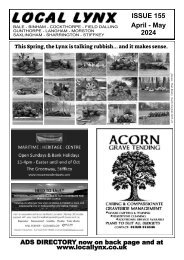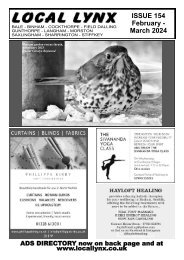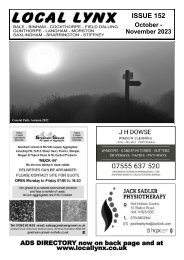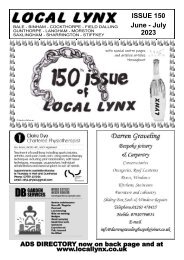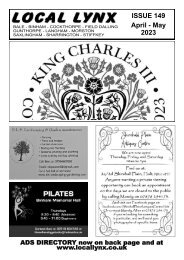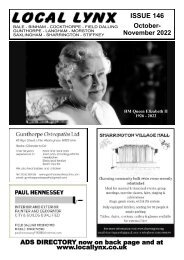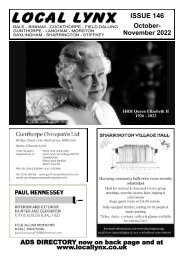Local Lynx No.151 August/September 2023
The communty newspaper for 10 North Norfolk villages.
The communty newspaper for 10 North Norfolk villages.
You also want an ePaper? Increase the reach of your titles
YUMPU automatically turns print PDFs into web optimized ePapers that Google loves.
position but, as some of you may know, I no longer live in<br />
Bale and feel it would be more fitting for a resident of Bale<br />
to take over. The number of hours you would need to<br />
commit to the role are very few as there are only six editions<br />
per year. Bale has several regular contributors so, unless you<br />
want to, you do not need to write articles yourself. However,<br />
you do need to know how to use a computer and Word.<br />
If you would like to have a chat with me about the role,<br />
please contact me on 07753 743542 or nab me at Fish and<br />
Chips, Bale Oak Bar or any other event at Bale village hall.<br />
I am happy to work with you until you feel confident to go it<br />
alone. I look forward to being overwhelmed with offers.<br />
Maggie Thomas<br />
TRIBUTE TO ANTHONY RICHARD<br />
HAYWARD OF BALE<br />
Anthony was born in the village of Trunch but was<br />
brought up on the family's remote farm at Little Fransham<br />
from the age of two. He was educated at St. Felix School,<br />
Felixstowe, and Oakham School, Rutland. He then studied<br />
at the College of Estate Management in London for two<br />
years and, after working at Tunbridge Wells for a year, he<br />
returned to Norfolk in 1964.<br />
Anthony was a Chartered Surveyor, Agricultural Valuer<br />
and Auctioneer and, upon his return to Norfolk, joined<br />
Andrews & Dewing (who later became Case & Dewing) at<br />
Wells-next-the-Sea. He moved to Bale in 1967.<br />
In 1989 Anthony started his own professional business<br />
and concentrated on what he most enjoyed doing, surveying<br />
and reporting on all types of buildings, until his retirement.<br />
He was a much-respected surveyor and his considerable<br />
knowledge of the area, its geography and byways, fuelled<br />
his love for his role as Parish Clerk, initially for Gunthorpe<br />
with Bale and later for Brinton with Sharrington. The<br />
former he served for 35 years and the latter 27 years, both<br />
positions fulfilled with passion.<br />
Anthony is remembered fondly in the village for his<br />
dedication to his work but also for his horse, "Leap", which<br />
lived to the age of thirty.<br />
He passed away very peacefully, after a long illness,<br />
with his wife, Dawn, by his side. He was a source of<br />
valuable work for the parish and a much trusted and reliable<br />
fountain of knowledge for our region. His expertise and<br />
smiling disposition will be sorely missed.<br />
AJE<br />
WILD BALE<br />
Purple Emperor<br />
It is high summer and a cascade of purple shimmers over<br />
the ‘master tree’ in a woodland glade. A battle ensues<br />
between the males as they circle around the treetops in<br />
search of a passing female.<br />
The Purple Emperor is one of our<br />
most attractive and rare butterflies. It<br />
is found in small colonies in large<br />
woods of mature oak and beech trees<br />
with damp areas where Goat Sallow<br />
grows, the food plant of the larvae. The adult butterflies feed<br />
on honeydew from the Goat Sallow leaves and from<br />
wounds in the bark and take salts from puddles on the<br />
ground.<br />
The second largest butterfly found in the UK, the Purple<br />
Emperor male has a wing span of 7.5cm and the larger<br />
female a span of 8.4cm. The sheen on the upper side of the<br />
male’s wing is a vivid purple, the females being a sooty<br />
black; both have splashes of white. The underside of both<br />
sexes is an orange, brown and white pattern with a large<br />
‘eye’ on the forewing. The eye is thought to replicate a<br />
predator, so providing some protection from attacks by<br />
small birds.<br />
In July and <strong>August</strong> the male perches high in a tree<br />
waiting for a female to pass. They then glide together and, if<br />
the female is receptive, they mate in the top of a tree and the<br />
female flies on while the male waits for the next female.<br />
The adult female will travel some distance to find a Goat<br />
Sallow or Common Sallow and lays a dozen or so eggs on<br />
the leaves, normally in the shade. The eggs hatch after ten<br />
days or so and the caterpillars will feed until their second<br />
larval change in November. They then form a silk home on<br />
the bark and remain there until spring when they emerge<br />
and feed, again as a caterpillar, until May/June when they<br />
form a chrysalis under the surface of a leaf, finally emerging<br />
as adults in July.<br />
Purple Emperors are restricted to southern England, the<br />
Midlands and East Anglia and, along with all British<br />
butterflies, have declined over recent decades. However, the<br />
population now appears to be increasing and expanding in<br />
7




